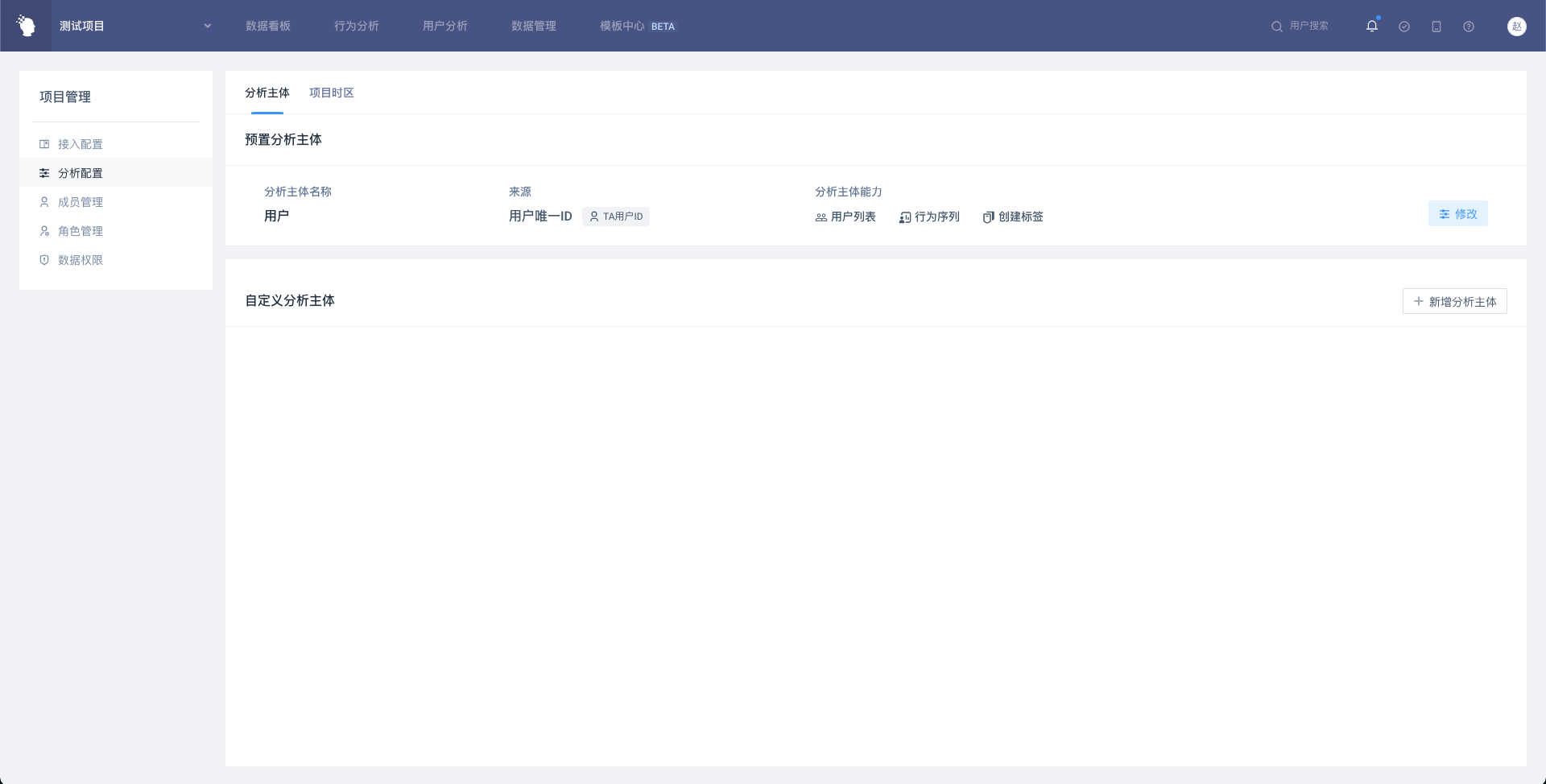# Analysis Subject
# I.The Significance of Analysis Subject
The analysis subject is to identify and analyze the unique user in different dimensions such as device ID, account ID, role ID, platform ID, etc. The TA user ID is the preset analysis subject. You can also use existing event attributes or user features as sources to create custom analysis subject, which can be used in retention analysis, funnel analysis, distribution analysis, interval analysis or tag group later.
# II. Location and Applicable Role of Analysis Subject
In the upper right corner of the page, select 'Project Management' to enter the Analysis Configuration > Analysis Subject menu.

- The preset analysis subject (TA user ID) is configured by default and cannot be deleted. You can modify the name.
- Custom analysis subjects need to be configured by yourself. If you have configured the "User Identity System" in version 3.3 and before, you can find it in the list of custom analysis subjects.
| Company supervisor | Administrator | Analyst | Ordinary members | |
|---|---|---|---|---|
| Configuration analysis subject | ● | ● | ○ | ○ |
| Using analysis subjects | ● | ● | ● | ○ |
Permission description:
● Role must have
▲ The role has the permission by default, but can revoke
△ The role is not available by default, but can be authorized
○ Role must not have
# III. The Specific Process of Analysis Subjects
# 3.1 Configure Analysts in Project Management
Enter Project Management > Analysis Configuration > Analysis Subject, click the 'Add Analysis Subject' button, and fill in the name and source of the analysis subject.

# 3.2 Usage in Analytical Models
At present, the four analysis models of retention analysis, funnel analysis, distribution analysis and interval analysis support switching analysis subjects. You can click on the upper right corner to view the configured analysis subjects. using preset analysis principals by default.

# 3.3 Use in Groups/ Tags
When creating a group or tag, you need to select one of the configured analytic subjects. The group/tag will be calculated based on the combined definition of the selected analytic subject. More content about creating custom analysis subject group/ tag can be viewed in user group and user tag.

# IV. Usage of Analysis Subject
# 4.1 Examples of Application Scenarios of Analytical Subjects in Retention Analysis
- What is the active retention/loss of each character dimension after the same user uses multiple game characters for a period of time?
- What is the retention/loss of core behaviors in the role dimension when user is fighting?
- The same user may log in with multiple devices. How does LTV perform from the device dimension?
# 4.2 Examples of Application Scenarios of Analytical Subjects in Funnel Analysis
- Analyze the level transformation in a certain period of time from the perspective of roles
- Analyze the transformation from the beginning of the battle to the victory of the battle in a certain period of time from the perspective of roles.
- Analyze the recharge conversion of new users in a certain period of time from the perspective of device.
# 4.3 Examples of Application Scenarios of Analytical Subjects in Distribution Analysis
- What is the level residence of the role dimension?
- What is the user activity in the device dimension?
- What is the distribution of players' recharge in the role dimension?
# V. Ability Differences of Analysis Subjects
# 5.1 Preset Analysis Subject (TA user ID)
Default use 'TA user ID' to identify users, 'TA user ID' different users will be as different users;
When using this analysis subject:
- Access to user list
- View user behavior sequences
- Can create tags / groups
# 5.2 Custom Analysis Subject
The user will be identified using the selected user feature or event attribute, such as 'Device ID', and users with different 'Device ID' will be identified as different users
When using this analysis subject:
- Access to user list
- User behavior sequences cannot be viewed
- Can create tags/groups
Note: If the analysis subject source is a virtual attribute and tags /groups have been used in the logic of the virtual attribute, the analysis subject will not be able to create tags/groups.
# VI. Best Applications
# 6.1 Use Custom Analysis Subjects in Models
In the calculation logic of retention, funnel, distribution and interval models, it is necessary to rely on the source attributes of the analysis subject for correlation calculation. For example, the distribution analysis model views the distribution of user login days. The results by role and by account are different. If there are multiple roles under one account, any role login on that day will be counted.
# 6.2 Analyze the Organizational Structure Dimensions of Users
In some cases, users may be in some organizational structures, such as guilds in games, shops in e-commerce, teachers who train APP, etc. If you want to analyze these dimensions, you can also use these attributes as the source of a custom analysis principal to switch to during analysis. For example, in the distribution analysis, when analyzing the payment amount, the analysis subject is switched to the 'guild', and the analysis result becomes the distribution of the sum payment amount of all roles under the guild.
